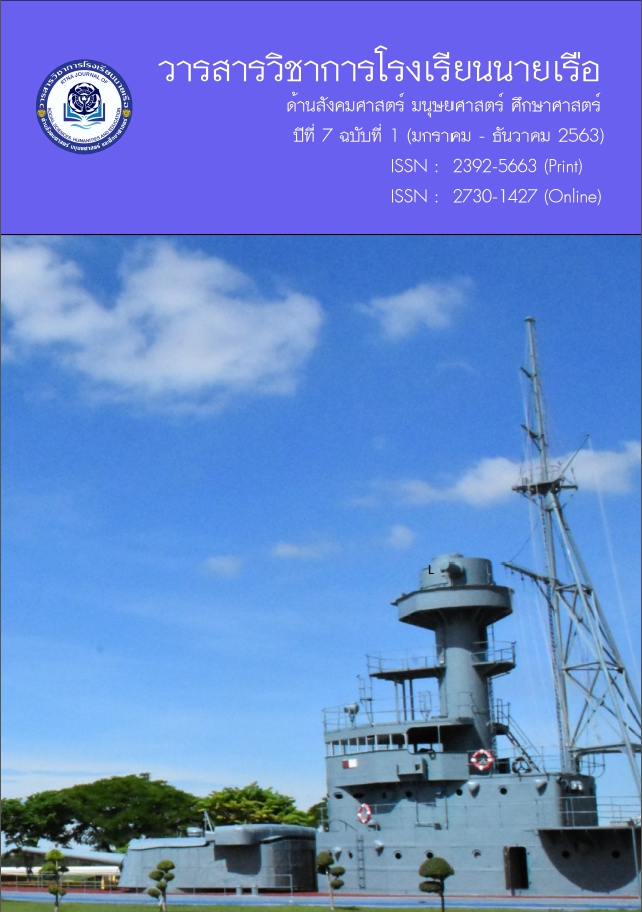Factors related to Organization Engagement among Personnel of Naval Medical Department
Keywords:
Organization Engagement, Happiness, Work Motivation, Human Resource DevelopmentAbstract
The purpose of this descriptive research was to study factors related to organization engagement among personnel of Naval Medical Department. The sample consisted of 2,534 personnel of Naval Medical Department, selected by stratified random sampling technique. The research instruments were personal factor, happiness, work motivation and organization engagement questionnaires. All questionnaires were tested for content validity with IOC index of and reliability with Cronbach’s alpha coefficients of .93. Data were analyzed by frequency, percentage, mean standard deviation and Pearson’s product moment correlation coefficient. The major findings were as follow: 1. Mean score of organization engagement was at the high level ( = 3.90, SD = 0.71) and 2. There was positively significant relationship between happiness, physical and psychiatric health, leadership, supervisor relationship, friend relationship, compensation, work environment, work life balance, clarity of duty, communication, challenge job, career development, career path, recognition, organization image, welfare and organization engagement was positive and moderate level which were statistically significant at the .05 level and work security and organization engagement was positive and high level which were statistically significant at the .05 level
References
กรมกำลังพลทหารเรือ. (2558). ยุทธศาสตร์กองทัพเรือ พ.ศ.2558-2567 ด้านการพัฒนากำลังพล. สืบค้น 10 กันยายน 2559, จาก http://www.person.navy.mi.th/personal/index1.php
กรมสุขภาพจิต. (2545). ดัชนีชี้วัดความสุขของคนไทย. สืบค้น 18 สิงหาคม 2559, จาก http://gg.gg/jqqae
กันต์ฤทัย ศรีโท และณัฐวีณ์ บุนนาค. (2560). ความผูกพันต่อองค์การของข้าราชการทหารชั้นประทวน หน่วยบัญชาการทหารพัฒนา กองบัญชาการกองทัพไทย. (วิทยานิพนธ์ปริญญามหาบัณฑิต). มหาวิทยาลัยเกษตรศาสตร์. สืบค้น 11 พฤศจิกายน 2560, จาก http://mapol.soc.ku.ac.th/wp-content/uploads/2017/09/5814851465.pdf
จิรประภา อัครบวร, รัตนศักดิ์ เจริญทรัพย์, จารุวรรณ ยอดระฆัง และขวัญ นวลสกุล. (2557). Emo-meter (Employee Engagement on meter) : เครื่องมือการวินิจฉัยความอยู่ดีมีสุขและความผูกพันของบุคลากร. กรุงเทพฯ: โครงการ "การบริหารทรัพยากรมนุษย์เพื่อนำองค์การไปสู่องค์การสุขภาวะ" สมาคมการจัดการงานบุคคลแห่งประเทศไทย.
จุติรัตน์ ถาวโร และภาสชนก พิชญเวทย์วงศา. (2551). ปัจจัยทำนายที่มีผลต่อความผูกพันต่อองค์กรของบุคลากรฝ่ายบริการพยาบาล โรงพยาบาลสงขลานครินทร์. สงขลานครินทร์เวชสาร, 26(5), 441-449.
ชนิดา เล็บครุฑ. (2554). ผลกระทบของคุณภาพชีวิตในการทํางานที่มีต่อความผูกพันต่อองค์การของบุคลากรสายสนับสนุน สถาบันบัณฑิตพัฒนบริหารศาสตร์. (รายงานผลการวิจัย). กรุงเทพฯ: สถาบันบัณฑิตพัฒนบริหารศาสตร์.
ชวลิต นุชกูล. (2556). ความผูกพันต่อองค์การกับประสิทธิผลองค์การกรณีศึกษา ข้าราชการทหาร สังกัดศูนย์รักษาความปลอดภัย กองบัญชาการกองทัพไทย. (วิทยานิพนธ์ปริญญามหาบัณฑิต). มหาวิทยาลัยเกริก. สืบค้น 10 ธันวาคม 2558, จาก http://gg.gg/jqqcc
ปัทมา สมสนั่น และรุจาภา แพงเกสร. (2556). การศึกษาความผูกพันต่อองค์การของข้าราชการทหารกองทัพบก. วารสารการตลาด และการสื่อสาร, 1(2), 775-795.
พวงพร กอจรัญจิตต์, ณัฐธกา เดชเกษม, กัลยา แก้วธนะสิน, นภสร ไชยภักดี และทรงศิริ นิลจุลกะ. (2560). ความสัมพันธร์ะหว่างปัจจัยส่วนบุคคล ประสิทธิภาพ การบริหารทรัพยากรมนุษย์ของกลุ่มภารกิจด้านการยาบาลกับความยึดมั่นผูกพันต่อองค์การของพยาบาลวิชาชีพ สถาบันสุขภาพเด็กแห่งชาติมหาราชินี. วารสารกรมการแพทย์, 42(2), 40-48.
ภรดี สีหบุตร. (2554). ความสัมพันธ์ระหว่างปัจจัยส่วนบุคคล และความยึดมั่นผูกพันต่อองค์การกับประสิทธิผลองค์การ ตามการรับรู้ของผู้ให้บริการ สถานพยาบาล สังกัดกองบัญชาการกองทัพไทย. (วิทยานิพนธ์ปริญญามหาบัณฑิต). มหาวิทยาลัยสุโขทัยธรรมาธิราช.
วัชราพร เชยสุวรรณ และคณะ. (2556). ปัจจัยที่สัมพันธ์กับการคงอยู่ในงานของอาจารย์ พยาบาลวิทยาลัยพยาบาลกองทัพเรือ. วารสารพยาบาลทหารบก. 14(1): 51-60.
สำนักงานคณะกรรมการพัฒนาระบบราชการ. (2558). เกณฑ์คุณภาพการบริหารจัดการภาครัฐ พ.ศ.2558. กรุงเทพฯ: สำนักงานคณะกรรมการพัฒนาระบบราชการ.
Alarcon, G., Lyons, J. B. and Tartaglia, F. (2010). Understanding predictors of engagement within the military. Military Psychology, 22, 301-310.
Buchanan, B. (1974). Building Organizational Commitment: The Socialization of Managersin Work Organizations. Administrative Science Quarterly, 19, 535-546.
Christian, M. S., Garza, A. S. and Slaughter, J. (2011). Work Engagement: A Quantitative Review and Test of Its Relations with Task and Contextual Performance. Personnel Psychology, 64, 89–136.
Herzberg, F. (1959). The Motivation to work. New York: John Wiley and Sons.
Hewitt Associates. (2003). Best Employers in Asia Research. The engagement model. Retrieved July 21, 2016, from http://www.asria.org/events/hongkong/june03/ index_html/lib/BestEmployersInAsia2003.pdf
Hewitt Associates. (2010). Hewitt Engagement Survey. Retrieved August 20, 2016, from http://www.hewittassociates.com/Intl/NA/enUS/Consulting/ServiceTool.aspx?cid=2256&sid=7212
Mackoff, B. (2011). Nurse Manager Engagement. Massachusetts: Jones&Bartlett learning.
Schaufeli W. B., Baker A. B. (2004). Job demands, job resources, and their relationship with burnout and engagement: A multi-sample study. Journal of Organizational Behavior, 25, 293–315.
Steers, R. M. and Porter, L. W. (1983). Motivation and work behavior. New York: McGraw-Hill.
Downloads
Published
Issue
Section
License
The author has the sole responsibility for the material published in RTNA Journal of Social Sciences, Humanities, and Education, which the editorial team may not agree on that material.
RTNA Journal of Social Sciences, Humanities, and Education owns the copyright of the text, the illustration, or other material published in the journal. No parts or the whole of the material published may be disseminated or used in any form without first obtaining written permission from the academy.






